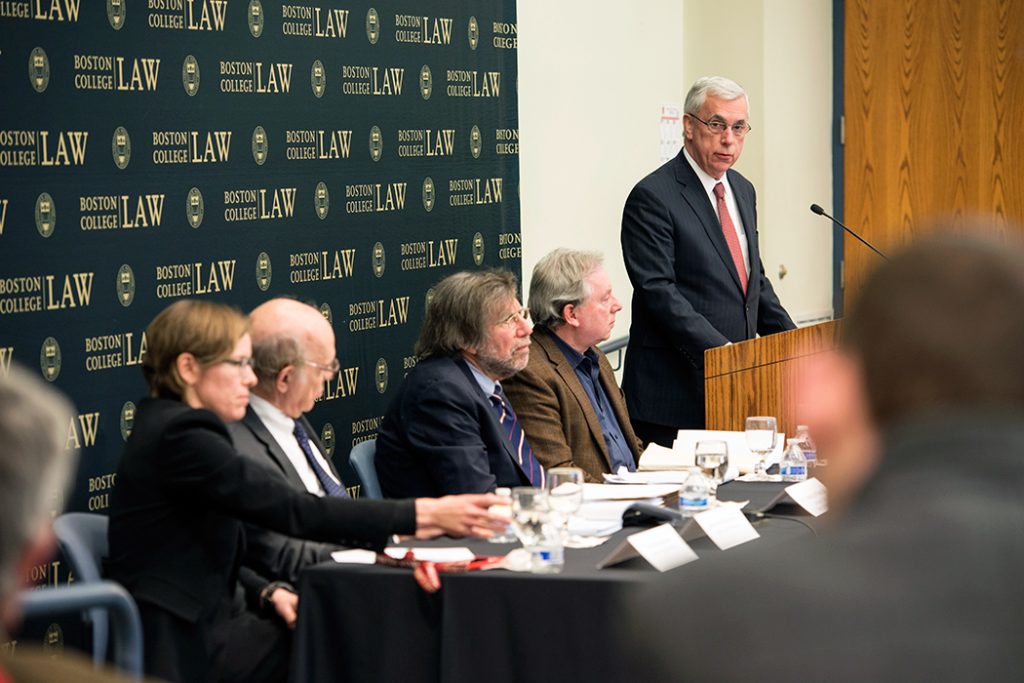On April 6, almost three years out from the 2013 Boston Marathon bombing, Boston College Law School welcomed one of the most pivotal legal figures in the bombing’s aftermath, Judge George O’Toole Jr. (standing) of the US District Court for the District of Massachusetts.
O’Toole presided over the 2015 trial of Dzhokar Tsarnaev, one of the marathon bombers, and the 2012 trial of Tarek Mehanna. Mehanna was a pharmacist who was convicted of providing material support to Al Queda.
O’Toole discussed national security and the role of the judiciary with a panel of national security experts that included Boston College Law School professors George Brown, Kari Hong, and Robert Bloom ’71.
Even though O’Toole was unable to refer to the details of the Tsarnaev and Mehanna cases, both of which are on appeal, he discussed the extensive jury selection process for the Tsarnaev trial, his denials of evidence, and how he dealt with the media. The theme of the event was the pursuit of justice and O’Toole’s effort to conduct fair trials.
He said that his goal in both the Mehanna and Tsarnaev cases was to follow the Sixth Amendment by having a speedy and public trial. In the judge’s opinion, the jury trial is both a judicial institution and an eminently democratic institution.
The trial was certainly public. Spectators, who were admitted on a first-come, first-served basis, began lining up to view the trial before dawn. There were also 72 media outlets that sought seating, and 30 were given seats on a rotating basis.
“We went to considerable effort to understand the needs of the media and provide for them,” the justice said.
O’Toole also described the massive jury selection process in the Tsarnaev case, a process he said he borrowed from the Whitey Bulger case. It took three months to whittle 3,000 potential jurors down to twelve jurors and eight alternates.
After 3,000 summonses were sent out in November 2014, approximately 1,400 potential jurors were brought to court. O’Toole described handling six sessions over three days, dealing with almost 450 people per day. Each juror had to fill out a 28-page questionnaire that asked about jurors’ backgrounds, attitudes towards the death penalty, and many other questions.
The lawyers produced lists of people who should be excused for cause. Jurors were then called to the courthouse for voir dire questions, a process that lasted twenty-one days. O’Toole’s normal voir dire practice is to ask questions in open court, he said, but for the Tsarnaev case, he asked questions in the more private jury room.
“The public-spiritedness of these jurors was remarkable throughout—the ones that were selected and the ones that were not,” Judge O’Toole said.
He was also cautious about the impact that social media might have on the jury and warned jurors of the dangers of doing independent research on the case and to refrain from many normal activities, which could expose them to information they should not have. “One of the features of the modern age is the use of social media.” O’Toole said. “Jurors’ use of social media is a concern of courts everywhere.”
O’Toole also talked about his handling of emotionally powerful evidence, which he said is a typical problem in terrorism cases. The court could exclude evidence that is relevant if the value is outweighed by prejudice or misleading the jury. “In both the Mehanna and Tsarnaev cases, the government offered graphic and violent images that would be disturbing to any person of ordinary sensibilities,” he said.
In these trials, the defense objected to much of this evidence, and O’Toole said he sustained some of the objections. He also cleverly allowed for certain evidence to be presented in a different manner. For example, at the Mehanna trial, O’Toole forbade a video showing dead American soldiers but allowed a government witness to testify about the images.
According O’Toole, denials of evidence are important spontaneous decisions. “A judgment call is made in the heat and pace of the action,” he said. “We have to make a call as we see it.”
After O’Toole spoke, Professor Brown discussed the judiciary’s active role in the war on terror, including the low standards the DC Circuit has created for detaining terrorists. He also mentioned his belief that Merrick Garland, President Obama’s nominee for the Supreme Court, is a pro-national-security judge.
Professor Robert Bloom posited that the death penalty was wrong in the Tsarnaev case. “As a native Bostonian, the story that I would have liked to have been told is how this great city, this city on the hill, came together,” Bloom said. “Pursuant to that end, I would have hoped that this would have been a non-death penalty case.”
The final speaker, Professor Kari Hong, described what she described as a dangerous trend, which is that that law enforcement asks for more power after terrorist attacks. “When thinking about terrorism, my call is just to think critically about the calls for expanded power, to ensure that they are related to a real harm, and they are not to the detriment of some real civil liberties,” she said.


